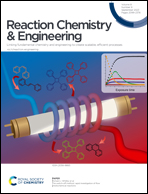Combining computational fluid dynamics, photon fate simulation and machine learning to optimize continuous-flow photocatalytic systems
Abstract
Photoredox catalysis is a well-established area with great potential for industrial applications. The need for an optimum process with less waste generation and economic and environmental appeal has led to several advances in this field. Nowadays, continuous flow microreactors are used to improve mass and photon transfer issues with good results compared to batch reactors. The small dimensions minimize the effects of the Beer–Lambert law, and the flow fields can be precisely known. However, when high throughput production is required, the advantages of this technology derived from its small size may be lost due to the increase in its dimensions. As a result, a more careful design is necessary to fully integrate this technology into the industry. On a design-case basis, improvements can be made to minimize some limitations, such as an efficiently illuminated surface-to-volume ratio in numbering up systems. Ray-tracing simulations can be a solution to this issue. It allows the tracking of photon fate and opens the possibility of improving the configuration of the microdevice to increase the reaction rate. A good mixing in the microchannels is also essential for a more homogeneous light distribution in the medium, despite some other flow-dependent issues, such as the formation of dead zones. CFD can clarify the phenomena occurring in a fluid in movement, and it has been applied for this purpose in several studies. Moreover, the CFD model can be linked to the ray-tracing model by using the photon flux simulations in microchannels as the light input for the chemical kinetics. Therefore, all the coupled phenomena taking place in these devices can be successfully simulated. However, the computational cost is one obstacle that cannot be overlooked in simulation-based design, optimization, and scale-out tasks. It is well understood that the more complex the model, the greater the computational effort required. As a result, we propose a framework in this paper that combines CFD, ray-tracing simulation, and machine learning to reduce the computational cost of complex tasks, allowing smart decisions fast and accurately. Data-driven models are used in machine learning, and results from CFD and optics simulations can be fed into the model to generate the predictions.



 Please wait while we load your content...
Please wait while we load your content...